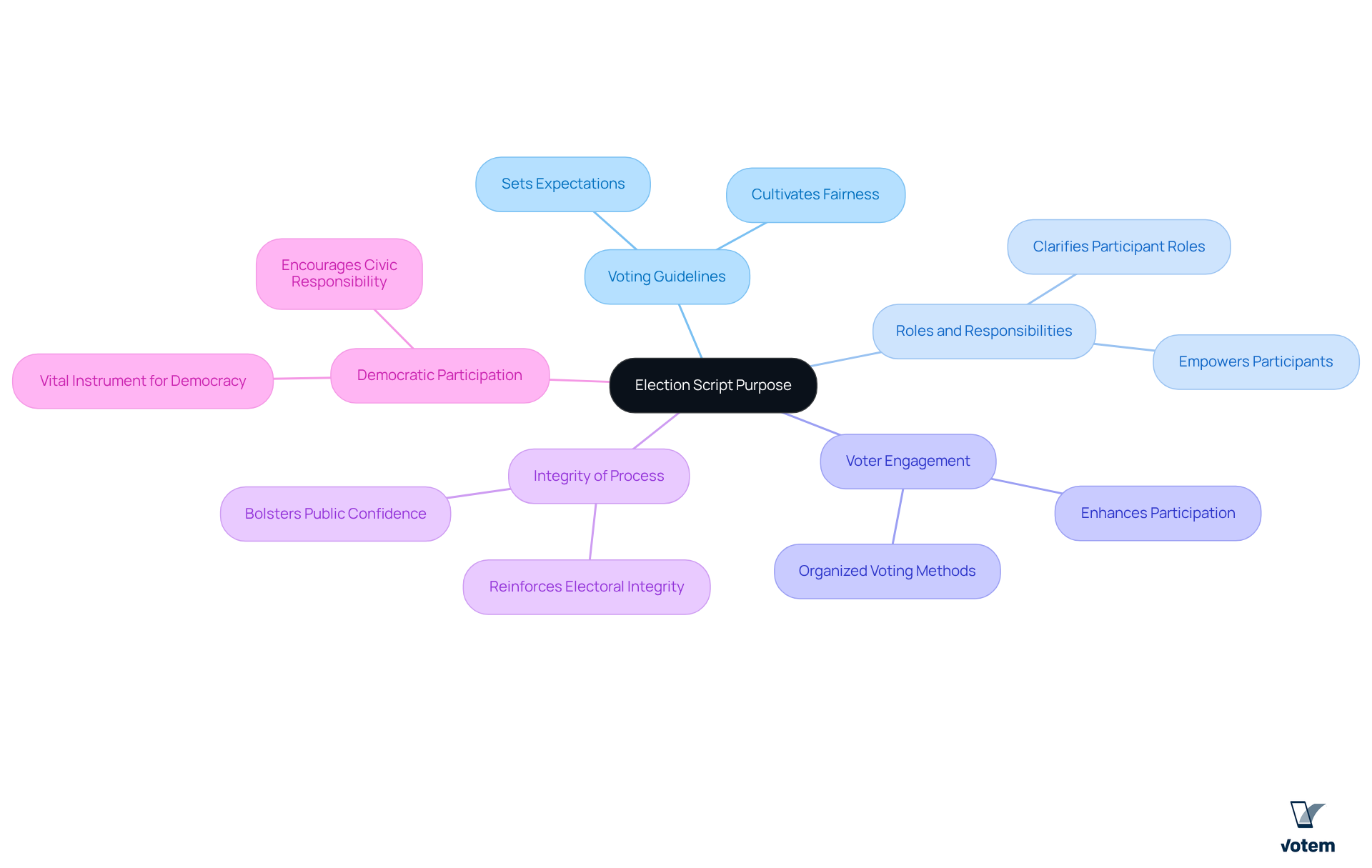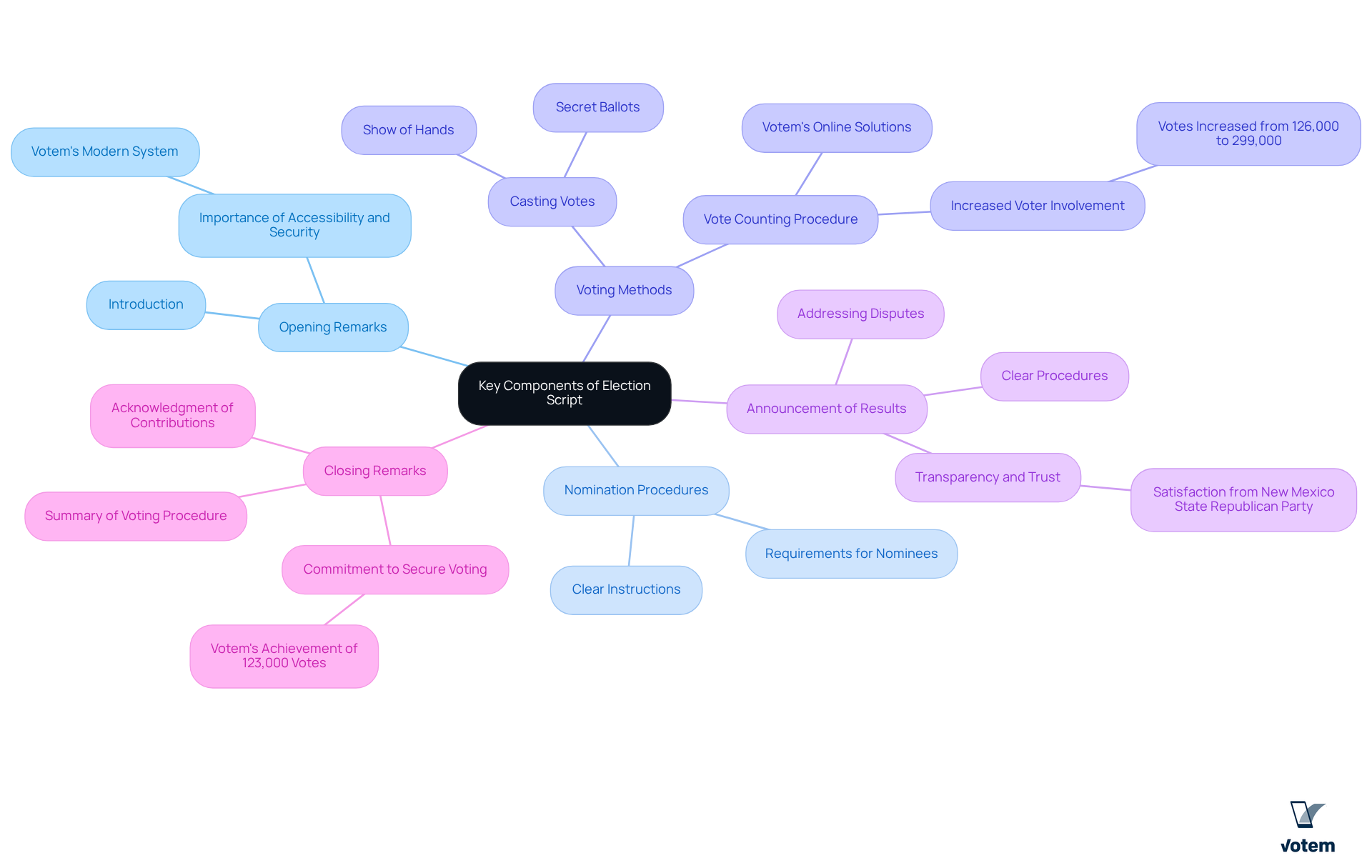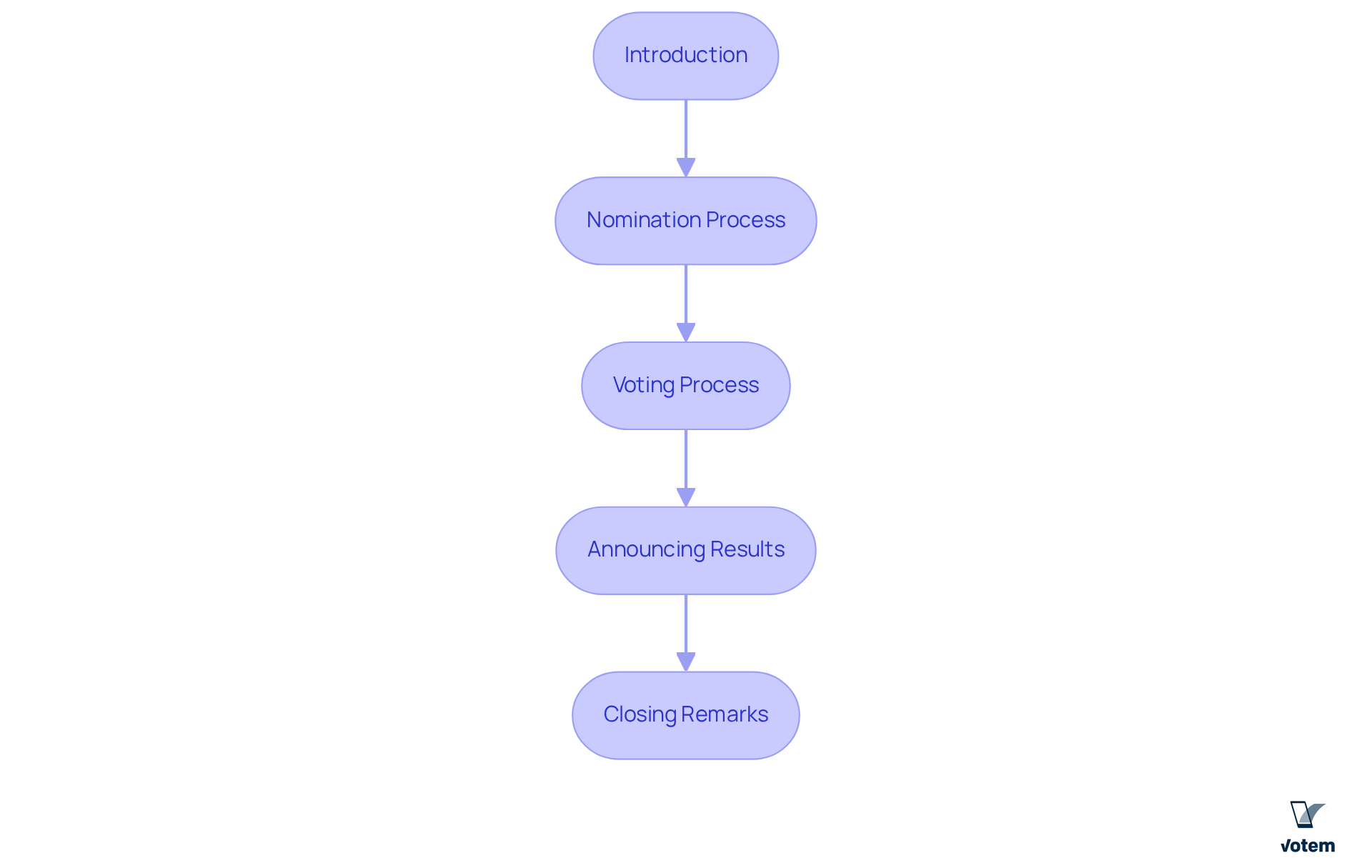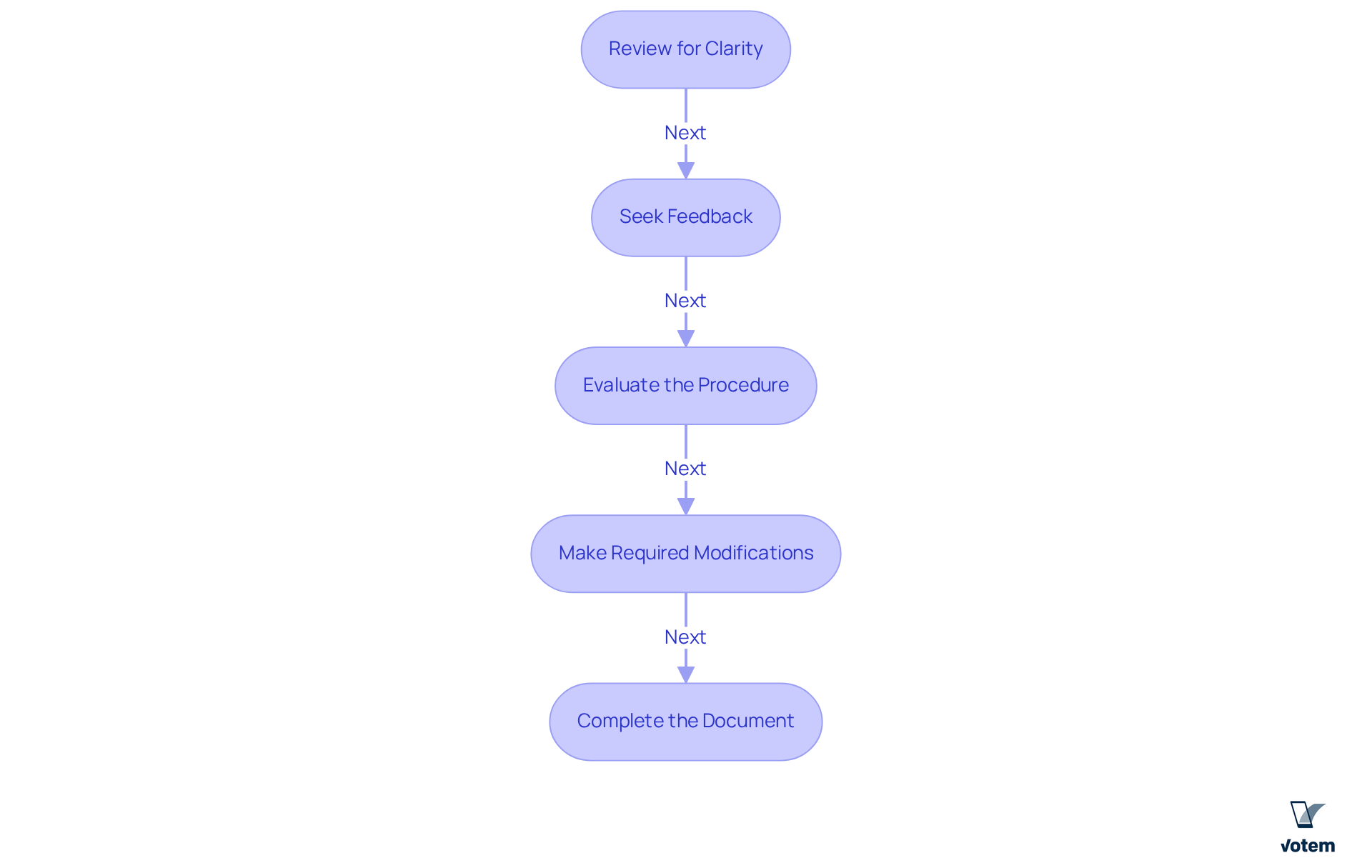Overview
The article delineates a four-step process designed to craft a sample script for the election of officers. This process emphasizes essential components, including:
- Opening remarks
- Nomination procedures
- Voting methods
- Result announcements
By adopting this structured approach, clarity and fairness in the electoral process are not only ensured but also foster enhanced voter engagement and trust in the outcomes. This is particularly evident in the examples of successful implementations of organized voting systems, which serve to illustrate the effectiveness of such a framework.
Introduction
Crafting an effective election script is not merely a procedural necessity; it is the backbone of a transparent and engaging democratic process. By establishing clear guidelines for nominations, voting methods, and result announcements, organizations can significantly enhance participation and trust among their members. This is crucial, as high levels of engagement foster a sense of community and ownership among voters. However, with numerous components to consider, how can one ensure that the script not only meets procedural requirements but also resonates with voters? This article delves into a step-by-step approach to creating a sample script for the election of officers, empowering organizations to cultivate a fair and inclusive electoral environment.
Understand the Purpose of the Election Script
The voting guidelines are a crucial framework for the officer selection process, delineating the procedures, roles, and responsibilities of all participants. By articulating these components with precision, the document cultivates a fair and efficient electoral environment. This clarity not only sets expectations for officials but also empowers participants, ensuring that their voices are acknowledged and respected.
Studies indicate that organized voting methods significantly enhance voter engagement; for instance, regions that implemented detailed voting guidelines saw a notable increase in participation rates. Furthermore, expert evaluations underscore that well-defined voting procedures bolster the integrity of the electoral process, thereby reinforcing public confidence in the outcomes.
Ultimately, the voting framework serves not merely as a procedural guide but as a vital instrument for enhancing democratic participation within the organization.

Identify Key Components of the Script
Key components of an effective election script include:
-
Opening Remarks: Begin with a concise introduction outlining the meeting’s purpose and the election procedure. Emphasize the critical importance of accessibility and security in voting. For instance, Linda McCulloch highlighted that implementing Votem’s modern system significantly improved access for participants in elections.
-
Nomination Procedures: Provide clear instructions on the nomination process, detailing any requirements for nominees. This ensures that all qualified candidates are duly considered, fostering a fair election environment.
-
Voting Methods: Outline how votes will be cast, such as through secret ballots or a show of hands, and describe the vote counting procedure. Votem’s innovative online voting solutions enhance this system, promoting greater involvement from all voters, including individuals with disabilities and military personnel. This is underscored by the National Radio Hall of Fame’s increase in votes from 126,000 to 299,000.
-
Announcement of Results: Establish clear procedures for announcing outcomes and addressing disputes or questions. This ensures transparency and builds trust in the voting system. The satisfaction expressed by the New Mexico State Republican Party regarding Votem’s software exemplifies the effectiveness of these procedures.
-
Closing Remarks: Conclude with a summary of the voting procedure and acknowledge the contributions of participants. Reinforce the commitment to a secure and accessible voting experience. Votem’s achievement of delivering 123,000 votes—more than double the turnout from the last election—highlights the significance of these guidelines.
By clearly outlining these components, the document acts as a sample script for election of officers, ensuring that all participants comprehend their roles and the overall process, which is vital for maintaining order and transparency. Votem’s proven track record of increasing voter turnout and satisfaction further underscores the effectiveness of these guidelines.

Draft the Election Script Step-by-Step
To draft an effective election script for union officer elections, follow these essential steps:
-
Start with an Introduction: Begin with a concise introduction that highlights the purpose of the event and underscores the significance of member participation. Increased participation in elections can lead to more representative leadership, as evidenced by various contests where turnout greatly influences results. Votem’s innovative online voting solutions have proven their ability to boost voter participation, ensuring that all members can easily engage in the process.
-
Outline the Nomination Process: Clearly specify how nominations will be conducted. For example, state, ‘The floor is now open for nominations. Please announce your name along with the nominee’s name.’ This clarity ensures that all members understand how to participate in the nomination procedure.
-
Detail the Voting Process: Describe the method for casting and counting votes. For instance, you might say, ‘Votes will be collected via secret ballot, and results will be announced immediately after the counting process is complete.’ Utilizing Votem’s secure and transparent voting platform enhances trust in the election results, providing verifiability and data transparency for all stakeholders involved.
-
Include a Section for Announcing Results: Prepare a text for announcing the results, such as, ‘The candidates for President are… and the results are…’ This section is crucial for transparency and maintaining trust among members. Votem’s commitment to providing transparent and dependable outcomes can further bolster confidence in the electoral system.
-
Conclude with Closing Remarks: Wrap up the document with a thank you to all participants and a reminder of the significance of their involvement in the organization. Highlighting the impact of member participation on overall union effectiveness can encourage future engagement. By utilizing Votem’s comprehensive support for voting, you can ensure a smooth and transparent process that reflects the collective voice of the union members.
By adhering to these steps and incorporating relevant statistics and best practices, you can create a thorough and clear electoral document, which includes a sample script for election of officers, that guarantees a seamless and transparent voting process.

Refine and Finalize the Election Script
To effectively refine and finalize your election script, it is crucial to follow these essential steps:
-
Review for Clarity: Begin by thoroughly reading the document to ensure that all instructions are straightforward and easily understood. Avoid jargon and complex language that may confuse participants.
-
Seek Feedback: Distribute the draft to trusted colleagues or members within the organization for their insights. Their viewpoints can assist in pinpointing aspects requiring clarification or improvement, which is essential for a successful voting procedure.
-
Evaluate the Procedure: Perform a simulated vote utilizing the procedure to uncover any real-world problems that might occur during the genuine voting process. Studies indicate that organizations conducting mock votes frequently experience enhanced results, as participants become accustomed to the processes and minimize mistakes on voting day.
-
Make Required Modifications: Based on the feedback obtained and the outcomes from the practice vote, update the text to address any noted issues. This iterative process is vital for ensuring that the final document is robust and effective.
-
Complete the Document: After making all necessary adjustments, format the text professionally and distribute it to all participants well in advance of the vote. This preparation fosters transparency and confidence among voters.
By dedicating time to refine and finalize the sample script for election of officers, you create a valuable resource that guides the election process, ultimately enhancing fairness and transparency in the electoral outcome.

Conclusion
Crafting a comprehensive election script is essential for ensuring a smooth and transparent officer selection process. This guide emphasizes the significance of structured voting guidelines, which not only clarify roles and responsibilities but also enhance democratic participation. By following the outlined steps, organizations can foster a fair electoral environment where every voice is heard and respected.
Key components of an effective election script include:
- Clear opening remarks
- Detailed nomination procedures
- Transparent voting methods
- A well-defined process for announcing results
Each element plays a crucial role in building trust and engagement among participants. Furthermore, the incorporation of innovative voting solutions, such as Votem’s platforms, enhances accessibility and participation, demonstrating the positive impact of well-crafted electoral frameworks.
In conclusion, the importance of a meticulously prepared election script cannot be overstated. It serves as a vital tool for promoting integrity and confidence in the electoral process. Organizations are encouraged to adopt these best practices and continually refine their scripts to reflect the collective voice of their members. By prioritizing clarity, transparency, and engagement, the electoral process can become a powerful mechanism for fostering representative leadership and strengthening community involvement.
Frequently Asked Questions
What is the purpose of the election script?
The election script serves as a framework for the officer selection process, outlining the procedures, roles, and responsibilities of all participants to create a fair and efficient electoral environment.
How do voting guidelines affect voter engagement?
Studies show that organized voting methods, including detailed voting guidelines, significantly enhance voter engagement, leading to increased participation rates in regions that implement them.
What impact do well-defined voting procedures have on the electoral process?
Well-defined voting procedures bolster the integrity of the electoral process and reinforce public confidence in the outcomes.
Why is clarity in voting guidelines important?
Clarity in voting guidelines sets expectations for officials and empowers participants, ensuring that their voices are acknowledged and respected.
How does the voting framework contribute to democratic participation?
The voting framework is not just a procedural guide; it is a vital instrument for enhancing democratic participation within the organization.
List of Sources
- Understand the Purpose of the Election Script
- Nominations & Elections – Texas PTA – every child. one voice. (https://txpta.org/nominations-elections)
- Homepage (https://electioncenter.org)
- Jesuit Resource – Election Day Quotes (https://xavier.edu/jesuitresource/online-resources/quote-archive1/election-dayvoting)
- Improving Participation in Democratic Processes (https://americanbar.org/groups/public_interest/election_law/american-democracy/our-work/improving-participation-democratic-processes)
- Voter Turnout – FairVote (https://fairvote.org/resources/voter-turnout)
- Identify Key Components of the Script
- [News Script: Union officer election] (https://digital.library.unt.edu/ark:/67531/metadc1146615)
- Quotes | Eisenhower Presidential Library (https://eisenhowerlibrary.gov/eisenhowers/quotes)
- Election Security Preparedness | U.S. Election Assistance Commission (https://eac.gov/election-officials/election-security-preparedness)
- Draft the Election Script Step-by-Step
- News | American Postal Workers Union (https://apwu.org/news)
- Turnout | 2024 European election results | European Parliament (https://results.elections.europa.eu/en/turnout)
- Checklist for Conducting Local Union Officer Elections (https://dol.gov/agencies/olms/compliance-assistance/elections/checklist)
- Refine and Finalize the Election Script
- Six ways the media influence elections (https://journalism.uoregon.edu/news/six-ways-media-influences-elections)
- OPA committee puts finishing touches on election materials – Worcester County News Bayside Gazette (https://baysideoc.net/opa-committee-puts-finishing-touches-on-election-materials)
- Quotes | Eisenhower Presidential Library (https://eisenhowerlibrary.gov/eisenhowers/quotes)
- How Media – Namely News, Ads and Social Posts – Can Shape an Election (https://rutgers.edu/news/how-media-namely-news-ads-and-social-posts-can-shape-election)

